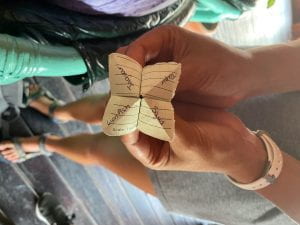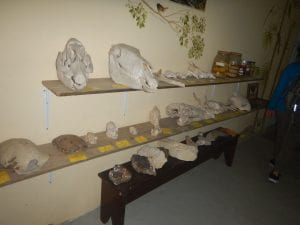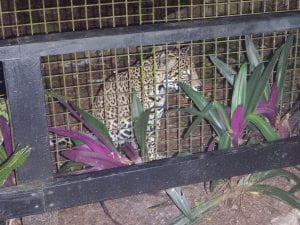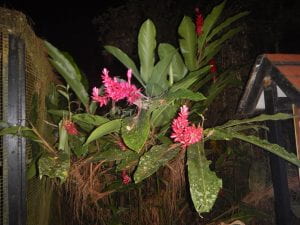May 23, 2025
Tag Archives: jaguar
Day 8: ATM Caves and Belize Zoo
Hi Blog,
Today was day 8 in Belize, and our last time in Las Cuevas. We promptly left Las Cuevas at around 7 AM for a 3 hour bus ride to the ATM caves. The bus ride went by soo quickly even though I was not asleep at all — I was listening to music and enjoying the scenery. We had breakfast in the car that Angie had packed for us. I missed hot sauce, but nevertheless, I devoured it.
Once we got to the ATM caves, we changed into our dive booties and began our 30 minute hike to the cave entrance. On our way, we had to cross three rivers. During the first river crossing, I not only slipped with the tour guides remarking “first one down,” but also gained a little tick buddy. I only noticed it there after Noelle had pointed out that there was something on my leg…. This was my first tick bite ever! We also had to pack socks for the dry chamber.
Once we got into the actual cave, the experience was surreal. We started out by a short swim to get past the cave entrance. I was wearing a light weatherproof jacket, and after the first river crossing, my socks were surprisingly dry, so I offered to put Lily and Ian’s socks in my pocket, but unfortunately…. they all got soaking wet during the swim to the cave entrance. We saw cute swarms of minnow-looking fish at the entrance though! After that, the water was usually only up to my knees or my torso.
We saw so many geologic formations, and it was astonishing to imagine that the very path we were adventuring through in the caves were where the Mayan people functioned. Along the way, we saw bats, a river catfish, and a spider. We had to maneuver through many slippery areas and some risky climbs, but all of us successfully made it to the dry chamber, where we then switched out of our dive booties to our (wet) socks.
In the dry chamber, we saw multiple human remains, such as 3 decapitated skulls of human sacrifices, a child’s mandible, and a calcified full human skeleton. It was also super interesting to see the countless Maya artifacts, such as the vessels and ceramics. Most of them were smashed, which apparently was to release the soul of each object after its use was completed. Throughout the entire caving, I was continuously astonished by how I am walking through an integral part of Maya culture, as caves served as a medium between the natural and supernatural worlds.
After the caving, we had lunch provided, which we all absolutely demolished. We then drove an hour to the Tropical Education Center and the Belize Zoo. The night tour of the Belize Zoo was so fun, as I got to see so many animals of my taxa (mammals) that I did not get to witness in the rainforest. We saw many species such and the neotropical river otter, jaguar, margay, kinkajou, tapir, puma, ocelot, and the Mexican hairy porcupine.
All of the animals we saw today were nocturnal species, so we did not get to see much (if any) diurnal species, but regardless, it was so cool to see SOO many mammals!
To begin with, the neotropical river otter we saw was floating around in the waters of its enclosure, and immediately jumped out of the water as soon as it saw the treat that the zookeeper had in hand for it. In fact, the otter also started making squealing noises in excitement!
We also saw two jaguars, which many of my classmates were most excited for. The first jaguar, a female, looked almost AI-generated, and I could not believe I was seeing a jaguar with my own eyes. The female jaguar was just behind the fence of the enclosure, staring at us (and the meat the zookeeper was holding). The zookeeper explained that this jaguar was confiscated from a tourist attraction where the jaguar was kept in very suboptimal conditions.
The second jaguar that we saw was a male one, and he had one of his eyes missing, which the zookeeper explained was due to enucleation (eye-removal) for glaucoma. This jaguar was also standing near the fence in plain sight. It was mainly still for the most part, except when the zookeeper fed him a treat.
It was then fascinating to think about how ~300 jaguars casually roam in the Chiquibul forest. They were most likely in close proximity to us during our hikes, just out of plain sight, especially since we actually were able to smell the distinct odor of cat urine at certain times.
We then moved on to the enclosure of margays. I had a really difficult time spotting them, even though people were pointing directly at it. After 3 minutes or so, I was finally able to see one. It was sitting in the corner of its habitat structure grooming itself. It was super adorable to see an almost super-miniature version of a jaguar, since margays are also spotted, only with the size of a household cat.
We then saw the kinkajou and mexican hairy porcupines. These creatures were interesting to see, as they both have prehensile tails, with allows them to use their tail almost as a fifth limb. The kinkajou was grabbing on to the branch, and got closer as the zookeeper fed him a banana. Likewise, the mexican hairy porcupine was also standing on a branch but did not react much.
An especially exciting portion of this tour was seeing the Baird’s Tapirs — the national mammal of Belize! Although I knew their approximate sizes beforehand, I was still astonished to see their quite immense size with my own eyes. We got to feed the tapirs with the treat that the zookeeper provided for us, and I was intrigued by how the tapirs looked like horses as they chewed.
It was super inspirational to learn about the founding story of the Belize Zoo by Ms. Sharon Matola and also how the Belize Zoo’s primary focus is on the well-being of animals since most of the intake is not only native animals but also from rescued, orphaned, injured, or abandoned backgrounds. I really thought it was meaningful to see how by seeing all of these animals in captivity, people, especially Belizean locals, were able to appreciate their natural heritage including the animals. Before, I think I viewed zoos in a subtly negative light, but after going to the Belize Zoo, I can now appreciate the impact on conservations that zoos can have. Of course, the state of animal welfare would depend per zoo, but from what I could observe, the Belize zoo appeared to be doing a really good job.

Tomorrow, we will eat breakfast at 8 AM then head over to Glover’s Reef on a 3(?) hour boat ride, which is presumably stunningly beautiful, so I am very excited for that. Well, I will see you guys tomorrow!
Mayan ATM Cave
Today we had a special opportunity to take a tour of the Maya ATM cave with Dr. Rodriguez and his team. After about a one mile hike to the cave entrance, we swam for about 50 yards into the cave. Here we trekked through the river, narrow passageways, and back into the chambers of the cave. We learned a lot about how the Mayans used the cave for rituals and their religious beliefs. We learned how the chambers of the cave corresponded with layers of the underworld and how the Mayans would sacrifice especially during hard periods of drought. Something I found very interesting was the levels of sacrifice. How the Mayans would move back further into the cave as they got more desperate and also sacrifice younger and younger as they grew more desperate.
We also took a trip to the Belize zoo where we got to see a lot of local animals such as jaguars, pumas, porcupines, ocelots, a kinkajou, a tapir, an owl, and a paca!
My beetle sighting for today was in the forest lodge bathroom sink and shower. Where several beetles were scurrying around.
Day 8: Indiana Jones style adventures
Today was an absolutely insane day. It started by leaving Las Cuevas (still sad about that part). We drove for about 2 hours until we got to Actun Tunichil Muknal Cave (or ATM Cave). I had been previously warned that this would be an adventure like no other, but even with all the hype surrounding today, the cave caught me by surprise.
(ATM entrance)
We swam into the cave’s wide open mouth and walked/swam through the cave for about an hour. In the water section of the cave, we saw incredible stalactites and stalagmites, bats roosting together, cave catfish, cave crickets, and cave spiders.
After about an hour of trekking through the watery cave system, we climbed up into a dry chamber. This cave system was used by the Mayas as a sacred ground for praying to gods of rain, corn, and the underworld. This specific cave was used as a location of often human sacrifice during the draught that wiped out their agriculture between 800 and 1000 AD. We saw calcified skeletons, broken and not broken pots and dishes, and fire pits used to light the cavern.
After we trekked back out of the cave and walked back to the van, I saw yet another basilisk lizard!!!!!! It was much larger but the same species as the one I caught yesterday (striped basilisk). I also saw two 7 ish inch long rose bellied lizards on the side of the trail which were incredibly fast after sitting in the sunlight. I did not get a great look at any of these lizards, but they were still cool.
Tonight, we went on a night tour of the Belize Zoo. We saw their rescued jaguars, ocelots, puma, margays, tapirs, paca, and crocodile. The jaguars were majestic so were super cool to watch.
(Jaguar!)
We did have one incident with an iguana however. It was a wild iguana that was resting too close to one of the electric fences, so our guide poked it to make it move. Instead of making it move a little however, this iguana SPRINTED away from us and then SPRINTED back right at us. My life flashed before my eyes. I do not know what this iguana could have done to me, but this iguana was so intense with its run. The iguana ran right into my leg and over my feet as well as right into two of my peers feet.
(demonic iguana)
Today was incredible and I want to do it again as soon as possible. But… TOMORROW IS TIME FOR REEF BIOLOGY! See you then!
Claire C
D-8 traveling to las Cuevas research station
Hi everyone!
Today has been a super long day! We woke up at our normal time (7 am breakfast) and ever since then we did not stop. After eating breakfast we all hurried to the boat, which we rode to Belize City. It took about 4 hours. Although it was a long ride, I can’t complain, the views were gorgeous! Also, thankfully most of us took Dramamine to avoid any chance of seasickness and it appears to have worked, as no one experienced nausea this time around! In fact, most of our crew was able to sleep throughout most of the ride!
After getting back to Belize City we ate at Calypso, a restaurant near where we were dropped off. The food was quite good, I got the pasta primavera! One interesting thing about the pasta was that it had a lot of pickles, something I hadn’t seen before in a pasta primavera; typically I’m not a fan of pickles, yet I think it made the pasta more flavorful!
Also, I thought for the remainder of this trip I would no longer see mention of my aquatic taxa, piscivorous fish, yet it seems like mentions of the lion fish continue haunting me.
After eating at calypso we quickly headed out to get to the Tropical Education Center, where we are spending the night. Yet, before getting to the TEC we made a stop a local store to get supplies for our time in the rainforest! Personally, the only thing I needed was bug spray, yet how could I say no to cookies, so I got some of those as well!
After our stop we then made it to the TEC where Dr. Aravalo talked to us about the Scarlet Macaw. The manner in which he presented his data made me very emotional for some reason. I was hoping to ask more questions, yet today we were on a roll and we could not prolong our Q&A for too long. After our talk with Dr. Aravalo we got dinner, out of which my favorite was the cake! After dinner we headed straight to the Zoo, which was a quick drive from the TEC. At the Zoo we got to see many of the nocturnal animals in the exhibit including the Jaguar and the Tapir and even a four-eyed possum (which was not a part of the exhibit).
I almost forgot to mention that earlier in the day, when we arrived at the TEC I saw really beautiful flowering plants, yet no bees nearby to indicate bee pollination.
At night while writing my blog I was a little sad I had not gotten to see bees today, yet things often occur when you least expect it! Tonight while showering I actually got to see my taxa. It wasn’t near any plants it was hovering over the light of my shower stall! Although it was too far up to get a good look I believe it was a Concave Nose Striped Sweat Bee.
Night Tour of the Belize Zoo!
Today was a long day of travels that began with a four hour boat ride that I thankfully slept through the majority of, with no seasickness! After having a leisurely lunch at a restaurant on the dock and making a much needed pit stop for more bug spray, we took a van to the Tropical Education Center just about an hour outside of Belize City. This place is so amazing I almost wish we could stay more than one night here! Watching the landscape change from coastal areas, to savannah, and now seeing the beginnings of a rainforest environment is so exciting and the TEC is such an enticing preview of what’s to come!
While here, we got to hear a wonderful guest lecture from Dr. Boris Arevalo, one of the experts on the ecology and conservation of the scarlet macaw, which is an endangered species here in Belize. He told us about his doctoral research into the nesting behavior and habitat selection of this species and his experiences as a biologist doing conservation work.
The highlight of today was undoubtedly our guided night tour of the Belize Zoo, just a 2 minute drive down the road! The zoo itself was so different than what you might typically expect from a zoo experience in the states, with plenty of rainforest wildlife existing inside and outside the cages, forming a more cohesive picture of these animals in their habitat. We saw so many cool nocturnal animals including Belize’s national animal, the tapir which has a very weirdly flexible snout. But my favorite animals we saw were the cats they had there! We got to see jaguars that knew how to roll over for treats, a grumbly ocelot, a puma, and some margays (one of the smallest wild cats!). I wish we could stay longer, but I am so excited to get to Las Cuevas tomorrow!
The Belize Zoo!
Hey guys! Once again, it’s Michiel : )
Today started out with us leaving Glover’s Reef! I’m sorry to leave it, but I’ve been really excited for this new part of our class. We had breakfast at 7, then everyone kept getting ready for the journey until about 9 (during that time I finished the book I was reading – Ghost Story by Peter Straub). At 9, we boarded the boat and began to depart from the reef. Faith and I had a really fun time while that was happening, because we got emails regarding our CHEM TA applications at that time, which we had to respond to, but the wifi from the island was getting further and further away. We were both able to respond before we lost connection, though : ).
The boat ride lasted about 4 hours. The majority of us fell asleep for most of the trip, but there were a couple of times that everyone was up to look for some dolphins (I didn’t get to see any). Also, a lot of people said that they had seen flying fish as we were leaving. Anyway, we got back to Belize City around 1, and we had lunch at Calypso, which is a restaurant right on the dock that we docked at. Then, we went to a grocery store, where I bough lots of items that I started running low on while we were on the island, and Ava and I both got a Klondike Bar, which was a wonderful treat for the both of us.
Later, we got to the Tropical Education Center, which is beautiful. The trails here are wonderful to walk on, and the cabanas are delightful to stay in. I’m really sad that we’re only staying here for one night. We were also given a presentation by Dr. Boris Arevalo on Scarlet Macaws. The data he presented was really interesting, but he masterfully weaved in advice throughout the presentation about doing research and continuing in our careers, which really motivated a lot of us to do incredible work in our futures. After the presentation, we had dinner, then we went to the Belize Zoo for a night tour! It was amazing. I saw a lot of my taxanomic group (mammals), including jaguars (Panthera onca), a puma (Puma concolor), an ocelot (Leopardus pardalis), a margay (Leopardus wiedii), white-lipped peccaries (Dycotiles pecari), a tapir (Tapirus bairdii), a paca (Agouti paca), and a northern tamandua (Tamandua mexicana). The jaguars would roll over and climb trees so that the zookeeper would feed them pieces of chicken (and one of them was named Lindo), and the ocelot made a really funny noise as it ate the chicken that literally sounded like “nom nom nom.” Also, we got to feed the tapir some carrots and feed it! It was adorable.
I’m really glad we saw all these species today, and I hope we get to see more at Las Cuevas. Here are some pictures I took during the tour!



Day 8: Authenticity (05/23/2017)
There we were, with flashlights in hand, meandering through the darkness of the Belize Zoo. The site was sprawling with tall tropical trees, including the Santa Maria tree (Calophyllum brasiliense) and the gumbo-limbo (Bursera simaruba), spectacular sights on their own. The Santa Maria trees, not very common and interspersed between shorter trees, had branches high up on the trunk and were some of the tallest trees at the zoo. The gumbo-limbo trees were also fairly uncommon and were shorter with bark that was peeling in fleshy-looking pinkish layers. I was unable to see any animal activity in the trees because we visited the zoo at night.
The trees were unscathed by the human activity necessary for the zoo’s survival; enclosures were constructed around established trees to preserve the integrity of the site. All of the zoo’s animals are native to Belize, and the zookeeper addressed each and every animal by name – Carlos the puma, Junior the jaguar, Maggie the frigatebird, Brutus the American crocodile.

One could feel the zoo’s authenticity. The zoo lacked kitsch. It lacked glamour. It was about people learning about the animals of Belize.
Earlier in the day, my class departed from Glover’s Reef, our home for the past week. Partway through our boat ride to the Belize mainland, we hiked and snorkeled through the Belize mangroves. At a glance, the area would not have looked appealing, with its sediment-filled water, knotted overgrown tree roots, and an absence of colors other than browns and corrupted greens.
However, the mangrove housed a wide variety of creatures. Today’s sightings covered the whole spectrum –red cushion sea stars (Oreaster reticulatus) to sun anemones (Stichodactyla helianthus) to a seahorse (Family Syngnathidae). The red cushion sea stars were amotile and were about six-inches in diameter. The most memorable sighting was a manatee (Genus Trichechus). Although I got little more than a glimpse of shimmery gray with chestnut speckles, it felt a sense an overwhelming sense of awe being in the present of a creature as majestic as a manatee.
Ecologically, mangroves are essential to the survival of many types of animals, including coral-residing species, as the shallow waters and networks of plant materials protect growing animals from predators. Despite not being the most popular image to send home on a postcard, mangroves are a necessity for the survival of countless living things.
That is authenticity.



















